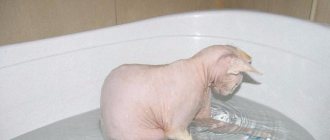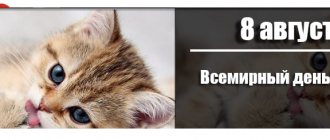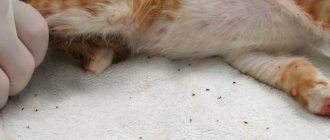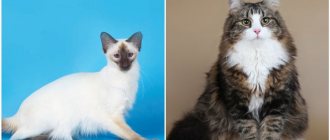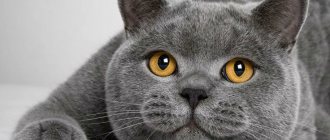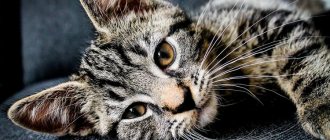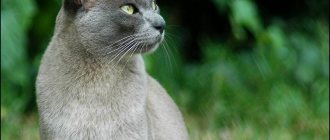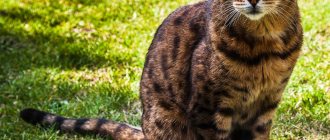History of the origin of the Canadian Sphynx breed
global $ads_google;
//data-ad-slot=”2475549904″ $ads_google = empty($ads_google) ? false : true; ?> if ($ads_google == false) {?> $ads_google = true; ?> } ?> Each cat breed has its own origin story. Hairless cats are known from historical references; Mexican hairless cats, which could be seen at exhibitions in the USA at the beginning of the last century, became especially famous. Representatives of the breed have not reached our time, remaining only in history.
From time to time, hairless kittens appeared in the world, but they were not interested in fixing this trait until a small kitten without hair was born in Ontario (Canada) in 1966 from an ordinary cat with a standard litter. The baby was named Prune and aroused the interest of felinologists in the hairless creatures of the Canadian breed.
Prune participated in inbreeding until the necessary genetic characteristics were fixed. We had to overcome serious difficulties with breeding and recognition of the breed. The ancestor of the stable breed was the hairless cat Epidermis, born in Wadena (Minnesota). To stabilize and consolidate the characteristics, they began to use the closely related Devon Rex breed, and today they are especially memorable for their funny, wrinkled beauty and grace of the creature.
Cat, cat and kittens
general description
The Sphynx is one of the most unusual and rare domestic cat breeds. Such an intriguing cat like the Sphynx will leave no one indifferent - some people are simply delighted with their hairless, wrinkled appearance, while others are simply horrified. In any case, it’s worth taking the time to get to know these wonderful cats better. They are soft like suede and very warm to the touch, making them a pleasure to cuddle in cold weather. Their wrinkled faces will remind you of the wisdom that comes with age, and their huge ears and lemon-shaped eyes will give the cats a unique look. Their round bodies make you smile. The Sphynx is certainly an interesting and mysterious cat breed for connoisseurs and connoisseurs.
brief information
- The skin of sphinxes is covered with fine hairs, like a peach.
- The Sphinx has large ears, reaching 5-7 cm.
- The Sphynx is friendly when meeting new people, so it is easier to deal with him at a show or at the veterinarian; he is a great family companion.
- The Sphynx is medium-sized, strong-boned, and athletic and muscular.
- Since the Sphynx does not have fur to absorb sebum secretions, it must be bathed frequently.
Story
Hairless cats are the result of natural spontaneous mutations in nature. The Sphynx is not the first case of hairlessness in domestic cats. The Book of Cats, published in 1903, features a pair of hairless cats called Mexican Hairless cats because they were discovered in New Mexico among local Indians. The ancient Aztec civilizations of Central America allegedly bred hairless cats hundreds of years ago. It is also known that in 1950 in Paris, three hairless kittens were born to a pair of Siamese cats. Other hairless cats have been discovered in Morocco, Australia, and North Carolina.
In 1966, in Toronto, Canada, an ordinary domestic short-haired black and white cat gave birth to a hairless kitten. It turned out that this was a natural genetic mutation that led to the emergence of the Sphynx breed as we know it today. The owner named the kitten "Prune" for his wrinkled skin and hairless appearance. A cat lover and Siamese breeder acquired this hairless kitten and used him as the founder of a new breed of cat with almost no fur.
Although most cat lovers have welcomed the Sphynx as a unique and exotic breed, the breed has also attracted negative attention. The mutation that caused hairless cats is considered by some experts to be a genetic disease because the cats are more susceptible to both heat and cold. On the other hand, Sphynx lovers argue that we humans are also naked compared to our closest relatives, but our species is thriving.
Appearance of the sphinxes
Sphynxes are one of several hairless breeds. They have a characteristic bright appearance, as these cats do not have hair. In fact, sphinxes are not always completely naked; there are different degrees of hairlessness. Their skin may be covered with a thin fluff, then the cat feels like a warm peach to the touch. Some short hairs are usually present on the nose, ears, back, and sometimes on the legs and tail. Seasonal and hormonal changes in a cat's body can also affect hair growth and amount. The fur is more noticeable on the body of kittens, and it disappears as they age. The texture of the Sphinx's skin can be compared to suede. In addition, in places the skin hangs loosely from the body, which leads to the appearance of cute folds that can be seen on a cat. In fact, Sphynx cats are no more wrinkly than any other cat, but the folds are more noticeable due to their lack of fur. Kittens' skin is more wrinkled than that of adult cats. However, adult Sphynx cats should still have some wrinkles, especially on the face, around the shoulders and neck. Sphynx cats have the normal body proportions of a cat. However, because they are hairless, their tail is often described as that of a rat. Sometimes there is a small strand of hair at the tip of the tail, then it is called a “lion's tail.”
Another distinctive feature is their huge ears, often more than 5-7 cm in height, triangular in shape, rounded at the ends and widely spaced, like the wings of a bat. The Sphynx also has large lemon-shaped eyes and wrinkles on the face, giving the cat an intelligent, inquisitive, anxious or inquisitive appearance. Eye color may vary. Mustaches and eyebrows may be present or completely absent. If they exist, they must be broken and rare. The Sphinx's head is wedge-shaped, with clear, prominent cheekbones. The cat's head sits on a long, elegant neck.
These cats have a strong, medium-large bone structure and an athletic and very muscular build. The Sphynx has a slender body, barrel chest, long slender legs and muscular thighs. Its paws are round, with long toes. These cats don't look fragile. As with most cats, adult males are larger than females. The Sphynx's belly gives the appearance that the cat has recently eaten a good dinner. Due to the lack of hair, cats accumulate oil on their skin, which can cause skin problems, so they need frequent bathing, ear cleaning, and nail trimming. Bathing a Sphynx is not difficult, since he gets used to this process from childhood. Care should be taken to limit Sphynx cats' exposure to sunlight, as they can burn quickly (as can fair-skinned humans).
Sphynx colors
These cats come in a variety of colors and patterns. The color of a cat is determined by the pigment of the skin and the color of those rare hairs that are present on the body. Sphynx cats can be tortoiseshell, chocolate, black, blue, white, etc., just like other cat breeds.
Personality
The Sphynx is an inquisitive, intelligent and very friendly cat. Warm and soft to the touch, the Sphynx often sleeps with its owner under a blanket. This breed is often referred to as “Velcro” and “knee cats”, which reflects the Sphynx’s desire to be on you and with you all the time. Sphynx cats love to meet new people who visit their home and get along well with dogs and other pets.
One of the most common questions about Sphynx cats is “Are they cold?” If you are cold, then your naked cat will be cold too. However, these cats are smart enough to find a warm spot in the house, curl up with a dog or cat, snuggle up with a warm person, climb on your computer or get under the covers.
Sphynx cats are very active and can entertain themselves for several hours. They need a lot of toys. Some cats can fetch things and enjoy playing with chasing prey. Their lively antics are a constant source of entertainment for their owners. Sphynx cats are loyal and devoted to their owners, they are very affectionate and devoted companions to everyone. They are sociable, very curious and enjoy the company of people and other pets. This is a friendly breed that is extremely people-oriented. The Sphynx usually greets its owners at the door with obvious excitement and happiness.
Temperament
These cats are very friendly and sociable with both people and other pets. Sphynx cats are very smart and can be easily taught to walk on a leash and respond to voice commands. They are often described as the smartest and most affectionate of all cat breeds. Sphynxes are energetic, agile, very active cats. This is a high-energy cat that can perform various acrobatic feats. Sphynxes balance well, easily climb onto doors and bookshelves, and even perch on their shoulders like birds. They love human attention and will do everything to attract it to their person. This is a loyal and affectionate pet towards its owners, which can even follow you around the house, wagging its tail. The Sphynx is a true extrovert, he will constantly demand your undivided attention and he simply hates being ignored. The Sphynx also gets along well with other animals, both cats and dogs.
Behavioral Traits
The Sphynx has a characteristic pose, which it often adopts by tucking one or both of its front paws under its belly. This breed of cat does not particularly like to be petted or vigorously petted, they like to just lie on your lap. Sphynx cats prefer to lie on warm, soft surfaces rather than on the ground or floor, so they can often be found on computer monitors, on sun-warmed windowsills, on the TV, or under a blanket. They sleep with their owners under a blanket, which is something you need to be prepared for. The Sphynx's natural curiosity can lead him into potentially dangerous situations. They certainly should not be left unattended outside for long periods of time.
Who are Sphynx dogs best suited for?
Sphynx cats are suitable for active families as they crave human attention. These cats need to be loved, given a lot of attention, care and affection, as well as the necessary care. Sphynx cats are very energetic and love to be the center of attention; they are not suitable for people who want a quiet and obedient cat.
Keep your Sphynx indoors to protect him from heat and cold, cars, diseases spread by other cats, and attacks from other animals.
Health characteristics (susceptibility to diseases)
Due to their relative hairlessness, Sphynx cats are particularly vulnerable and sensitive to climate change - particularly heat and cold. They should not be allowed outside unattended in cold weather as they cannot effectively retain body heat. They are also prone to sunburn and skin burns when exposed to the sun. Sphynx cats are also prone to developing allergies. If their skin is not taken care of properly, it will also quickly develop problems. Sphynx cats need to be bathed regularly - at least once a week.
Are Sphynx cats hypoallergenic?
It is a very common misconception that Sphynx cats are hypoallergenic due to their lack of fur. Sphynx cats may be hairless, but they are not hypoallergenic as they still have dandruff, which is formed from dead skin cells. Allergies are not caused by fur, but by an allergenic protein that is secreted through the saliva, sebaceous glands and dander that all cats (and humans, for that matter) have. There is no scientific evidence that any cat breed is more or less allergenic than any other. Some people with allergies react less severely to these cats, but no breeder can guarantee that their cats will not cause an allergy in you.
Purchase
Prices for Sphynx cats strongly depend on the health, personality and temperament of the kitten, and its pedigree. It is recommended not to give kittens to new owners until twelve to sixteen weeks in order to get all the necessary vaccinations and ensure their full physical and social development. It is also important to check the kitten's health with a veterinarian. Sphynx kittens need a good diet high in protein and other nutrients to maintain optimal health. The Sphinx is a rare treasure that must be kept indoors, surrounded by love and care to maintain a healthy, long and happy life.
Don't choose a Sphynx solely for its strange appearance. The Sphinx is so much more, he is a personality, an individual, curious, smart and funny. He loves people, loves to sleep with you under the covers, loves to be the center of your attention, so be prepared for his cute antics.
Description and standards of the Canadian Sphynx
If you want to characterize the appearance of the Sphinx, then the epithets elegant, graceful, strong, extraordinary are suitable. This cat deserves this description due to the outline of its body and the velvety quality of its sometimes folded skin.
The Canadian cat is a medium-sized animal that, although relatively small, has a muscular body and a wide chest.
The front legs are widely spaced, the hind legs are longer than the front ones, which makes the Sphinx's body visually more graceful. The Canadian's paws are slightly curved, and since the toes have thick pads, it seems that the cat is walking as if in heels.
The peculiarity of the breed is that the skin of a Canadian kitten has numerous folds until the baby is one month old, then the folds gradually disappear. Adult cats have folds near the face, around the neck and between the ears. Sometimes folds are noticeable on the stomach.
Anyone who has ever stroked such a sphinx will say that he is not completely “naked”, but covered with a small soft velor fluff. Vibrissae are usually absent, but individuals with short antennae are found.
The Sphynx's ears are memorable for their large size, they are erect and set wide apart, with rounded tips. It is noteworthy that a small fluff sometimes grows near the base of the ears.
The shape of the head resembles a wedge, almost identical in length to width. Cheekbones are clearly visible.
Slightly slanted eyes are shaped like a good large lemon. There is quite a long distance between them. The eye color usually matches the coat perfectly.
The straight cat nose looks interesting in combination with a clearly visible hollow located at the transition from the forehead to the nose.
global $ads_google; //data-ad-slot=”2475549904″ $ads_google = empty($ads_google) ? false : true; ?> if ($ads_google == false) {?> $ads_google = true; ?> } ?>
According to the Sphynx standard, a large number of colors are acceptable. Particularly popular colors:
- harlequin;
- chocolate;
- bicolor;
- blue;
- black;
- grey;
- lilac;
- van;
- brindle;
- Siamese (color-point variety).
Although the fur of this cat is considered hypoallergenic, nevertheless, an allergy can occur, since a person’s reaction is not to the fur itself, but to the protein that the pussy secretes along with liquid secretion.
Interestingly, by winter the animal can become slightly overgrown with short fluff.
Dimensions and weight of the Canadian Sphynx
The size of adult animals does not exceed average. The weight of the Canadian is quite light and depends on gender: females weigh less than males. The body weight of cats is about 3.5 kg, and males up to 5 kg.
Using the table below, you can find out whether your pet fits the ideal size of an adult healthy Sphynx.
| Category | Signs |
| Thin | The ribs and bones are visible, the fat layer is only on the chest. The pelvic bones are visible. |
| Normal | We can feel the fat layer on the abdomen, the waist is not visible, and it is also quite difficult to feel the ribs, spine and pelvic bones. |
| Thick | The animal is round in appearance, the ribs and bones are not at all easy to feel, the fat layer is pronounced. |
What is the difference between the Canadian Sphynx and the Don Sphynx?
Maybe for someone who meets a Sphynx for the first time in their life, there are no special differences at the first inexperienced glance, but these are different breeds of cats with differences and differences in standards.
If we compare the origin stories of the Sphynx, the Donetsk appeared quite recently and began their journey around the world from Russia, while the Canadians have a history of the breed that goes back over half a century.
The Don Chak lacks fur due to crossings with smooth, short-haired breeds; the Canadian has a recessive gene for “baldness.”
a Canadian cat with your eyes closed - he always has a tiny fluff on his body, the Don brothers may have fur or not have it at all.
global $ads_google; //data-ad-slot=”2475549904″ $ads_google = empty($ads_google) ? false : true; ?> if ($ads_google == false) {?> $ads_google = true; ?> } ?>
The Don beauties have special types of coat: brush, flock and velor. Velor cats exhibit fur up to 3 cm long, while brush cats sport coarse, curly fur.
Where and how did hairless cats come from?
You know that regarding the appearance of hairless cats, there is a rather bold version that these cats are representatives of an extraterrestrial civilization. And just as not everyone can appreciate a real jewel, not everyone likes hairless cats. By the way, if you think that Sphynx cats (this sounds much more pleasant than just “hairless cats” - this is the same as an ordinary cat, but devoid of fur), then we want to disappoint you - no matter how you shave your Murka bald, she will never become a real hairless cat. You have to be born a Sphinx...
It is noteworthy that the appearance of cats devoid of hair is not at all an experimental development of human hands. Not at all. Nature itself developed this hairlessness gene from generation to generation of cats, and finally, as a result of a spontaneous mutation, the Sphynx cat was born. Such cats without hair were born in America, Canada, France and Australia...
Well, the first hairless cat (it came from Mexico) was described in a book by Francis Simpson in 1903. Then 2 cats, devoid of fur, were purchased from one leader of an Indian tribe, however, since they were brother and sister, the owner did not subsequently breed them, and this breed was not continued. True, descriptions of the owner of these cats have survived to this day - he admired their intelligence, kindness, as well as such human traits as a love of water treatments, understanding of human speech, and a weakness for soft feather beds. However, these cats, as we wrote above, did not give birth to offspring.
The next mention of hairless kittens was in 1938. Then a professor in the field of genetics, R. Letard, reported that 2 kittens without hair were born from two Siamese cats. A little more than 10 years will pass before a case of the birth of 3 hairless kittens from a Siamese cat was recorded in France. The owners decided to try to breed a new breed and subsequently crossed these hairless kittens, however, there is no information regarding the quality of further offspring...
If you try to mark on a map the geography of the appearance of this breed in different parts of the world, you can see that periodically such cats without hair appeared in different parts of the world. However, Sphynx cats have become the most successful breed, which has received international recognition and acquired its own characteristic features that have not changed from generation to generation. Why were these cats called sphinxes? The fact is that their appearance was very reminiscent of Egyptian sculptures of sphinxes. Who knows, perhaps the very first hairless cats appeared there...
Today, the most famous are 3 breeds of such cats with no fur - the Canadian Sphynx, the Petersburg Sphynx (also called Peterball) and the Don Sphynx. The difference between representatives of these breeds is not only in the name, but also in phenotypic characteristics and in the genetics of hairlessness itself.
Characteristics of Canadians
It is worth listening to reviews from owners about the character of Canadian breed cats. As a rule, they sing long praises to their pets, but, to the animals’ credit, the odes of praise are fully deserved.
The character of these cats is similar to other four-legged animals - dogs. Cats are easy to train, as they are quite intelligent and can learn to fetch small objects and perform various tricks such as opening windows and doors.
They begin the training process by training them to use the tray and responding to their name. A kitten of this breed remembers all this almost the first time.
Sphinxes are very socialized, so they prefer to communicate with their owner, to whom they are infinitely loyal. The cat and the owner can watch TV together for a long time, and then also go for a walk around the apartment together.
The sphinx reacts calmly to other animals; the hunter's skill is fast asleep in him.
Care and feeding of the Canadian Sphynx
The maintenance of Canadians includes the main points of care and nutrition.
You will have to take special care of your cat.
The Sphynx's eyes are not protected by eyelashes or fur, and accumulated discharge from the corners of the eyes must be removed with a damp cloth. Cotton wool should not be used; it can irritate the skin around the eyes.
You should not ignore the fact that these cats are very sweaty - sweat is released throughout the body, staining the owner’s clothes and furniture in the apartment. The animal is regularly wiped with a damp cloth and bathed; if this is not done, the Sphynx’s body will become a dirty chocolate shade.
Feeding Canadian cats also has its own nuances. Starting from the pet's childhood, the owner should follow advice on how to feed a kitten of different ages. The diet of kittens at two months will differ from the diet of a baby at three months.
Since the cat is hairless, its heat exchange is much higher, so a healthy Sphynx always has a good appetite. The ideal food is lean meat, porridge, offal. Since your cat sweats a lot, you need to make sure there is fresh water in the bowl.
Health of Canadian hairless cats
In general, the health of cats is not great; they have a predisposition to obesity, acne, and dermatitis. The list of possible diseases suggests that a person should be attentive to his pet. Timely vaccinations given by the attending veterinarian will help against many diseases. The vaccine will be more active if deworming is carried out 2 weeks before it.
The Sphynx's pregnancy lasts 52-68 days, a litter usually contains 3-6 kittens, and the owner's help is desirable during childbirth.
In cases where mating is not planned, it makes sense to castrate the cat; this will not affect its character in any way.
Canadian cats are very hot: 38.5° C - this is the normal body temperature for a healthy Sphynx.
The life expectancy of the Canadian Sphynx is 13-15 years , but there are also centenarians who have celebrated their 19th birthday.
Character and habits of sphinxes
Sphynx cats really need human interaction, and this distinguishes them from many other cat breeds. They are loving, love to sit on laps, and enjoy being petted. The Sphynx does not like to be alone for a long time, so these cats are not suitable for people who are always busy at work.
Sphinxes are completely non-aggressive, friendly and friendly. They are ready to meet new people, willingly allow themselves to be petted and prefer not to show aggression. These cats are well suited for families with children, as they love to play and will never offend a person. You can choose to overcome obstacles as games with sphinxes - these cats are excellent at learning.
Interesting fact: Sphinxes do not have a tendency towards vengeance, and they are not at all vindictive. At the same time, sphinxes are extremely vulnerable animals, so you should treat them kindly and friendly. You should not yell at them, much less hit them, as this can make the cat depressed. Sphinxes easily get psychological trauma, which is why their life expectancy is reduced.
Sphinxes are very curious. They love to climb into inaccessible places in the house and always pay attention to new objects. Therefore, they should hide prickly and cutting things, since curious cats will definitely get to them.
The Sphinx will never perceive itself as inferior to a person. Only partnerships are possible with these cats, in which the sphinx is a full-fledged member of the family. Because of this, you should not expect that the Sphinx will unquestioningly obey and carry out commands. Therefore, it is generally accepted that these cats are characterized by stubbornness and pride.
Sphynxes get along well with other animals, they are not even afraid of dogs. At the same time, the sphinx will not be jealous of the owner of other pets if they devote enough time to everyone.
Buy a Sphynx kitten
global $ads_google;
//data-ad-slot=”2475549904″ $ads_google = empty($ads_google) ? false : true; ?> if ($ads_google == false) {?> $ads_google = true; ?> } ?> There are many nurseries in Russia where you can buy a Canadian kitten. You shouldn’t trust sellers on Avito and other resources if you don’t want to get a “pig in a poke.”
The cost of Sphynx babies is not that high. The price for a baby averages 6-8 thousand rubles and may be higher depending on the pedigree.
What to name a Canadian Sphynx
A tiny sphinx has appeared in the house, and its external characteristics will not be very consonant with the simple name Vasya or Murka?
It is worth worrying about choosing a suitable nickname for a cat with such graceful body lines and such a non-standard appearance. Nickname table
| Girl | Boy | ||
| Yesya Kamila Amalia Deya Ishka Yupi Liksi Lika Fisa Sony Amanda Agata Osti Sara Oxy | Mike Bella Ressi Bonya Eva Fisha Lysya Lana Fabira Bast Vita Aisha Aurora Aika Adriana | Noir Doris Tahir Argo Irzhik Tahir Weiss Laurie Grief Edmond Jean Riggi Icarus Count Yoda | Veron Born Prune Dary Elf Skin Barik Lucky Lasker Azar Bigglesworth Tyson Tristan Vin Diesel Freeman |
Conclusions about the breed
It is not for nothing that the Canadian cat - the animal is very graceful, beautiful and has a high level of intelligence.
The owners of Sphynx cats do not complain about the cats being picky about food, but they warn that it will not be possible to take care of their pet carelessly.
The animal of the Canadian Sphynx breed needs increased attention from the owner, and the time that the cat spends in the house becomes happy for the whole family.
global $ads_google; //data-ad-slot=”2475549904″ $ads_google = empty($ads_google) ? false : true; ?> if ($ads_google == false) {?> $ads_google = true; ?> } ?>
Varieties of the Sphynx breed
Today there are seven varieties of the Sphynx breed. Three of them are called pioneers - the main branches of the breed that arose as a result of spontaneous mutation, naturally. The rest are a product of selection; they were bred later.
As a result of spontaneous mutations, the following appeared:
- Canadian Sphynx;
- Don Sphinx;
- Cohona (rubber, Hawaiian hairless)
As a result of breeding programs, the following were developed:
- The Peterbald was obtained by crossing the Don Sphynx and an Oriental cat.
- Minskin, the Canadian Sphynx, Munchkin, Devon Rex and Burmese were used for breeding.
- Bambinle is a Canadian Sphynx and a Munchkin.
- Ukrainian Levkoy was obtained by crossing the Don Sphynx, Peterbald, Oriental, Scottish Fold, Persian, and domestic cats.
